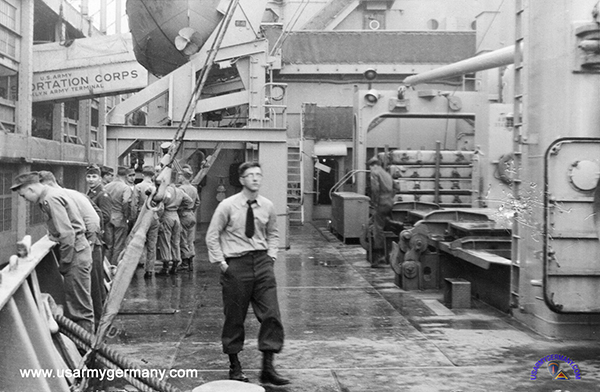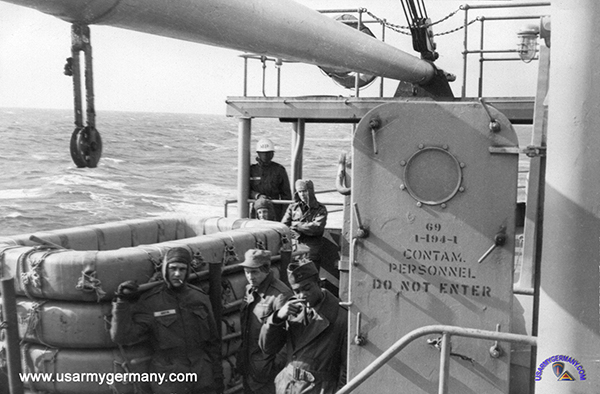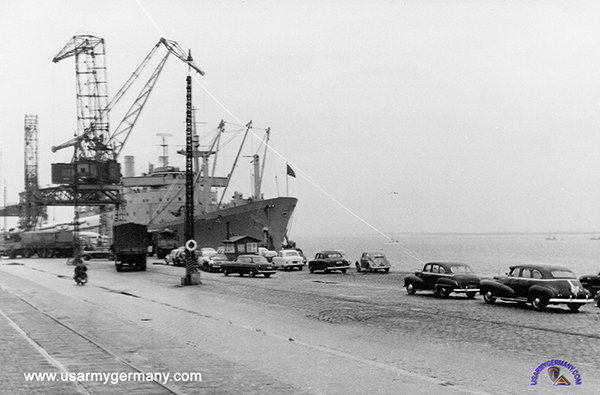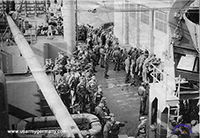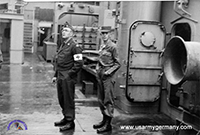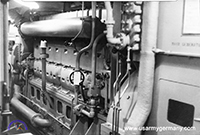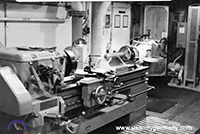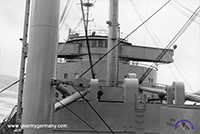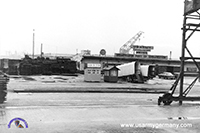Military Sea Transportation Service |
|||||||||||||||||||||||||||||||||||||||||||||
|
|
|||||||||||||||||||||||||||||||||||||||||||||
|
|||||||||||||||||||||||||||||||||||||||||||||
|
|
|||||||||||||||||||||||||||||||||||||||||||||
| Military Sea Transportation Service - Eastern Atlantic and Mediterranean | |||||||||||||||||||||||||||||||||||||||||||||
| In 1949 (Oct 1), the Military Sea Transportation Service became the single managing agency for the Department of Defense's ocean transportation needs. The command assumed responsibility for providing sealift and ocean transportation for all military services as well as for other government agencies. Prior to that, four separate government agencies (including the Army Transportation Service) controlled sea transportation. The MSTS Area office, originally set up in Heidelberg in 1949, was moved to London in 1951. |
|||||||||||||||||||||||||||||||||||||||||||||
| 1950 | |||||||||||||||||||||||||||||||||||||||||||||
| (Source: STARS & STRIPES, Jan 3, 1950) | |||||||||||||||||||||||||||||||||||||||||||||
| Operations offices for the Military Sea Transportation Service will be established at Bremerhaven Port of Embarkation, Trieste and in the London-Southampton area to provide for the movement of U.S. military and civilian personnel and cargo by surface vessel between Europe and the U.S.
Capt. John M. Will, USN, of Perth Amboy, N. J. has been named MSTS representative for Europe, and is directing the organization of the service on the Continent and in Great Britain. He is making his headquarters in Heidelberg in order to maintain closer liaison with the EUCOM transportation division, which has been handling the sea and land transportation of EUCOM personnel. Within the next few months, MSTS will take over the operation of Army transports. |
|||||||||||||||||||||||||||||||||||||||||||||
| (Source: STARS & STRIPES, March 7, 1950) | |||||||||||||||||||||||||||||||||||||||||||||
| 72 seagoing transports of the US Army Transportation Corps have been transferred to the Military Sea Transportation Service. 42 of the ships that operate in the Atlantic were handed over to the Navy in a ceremony on the transport General Alexander M. Patch at the Brooklyn Army Base, while the remaining 30 that operate in the Pacific were transferred in ceremonies at San Francisco and Seattle. The transfer affected only the Army's deep-water operations and did not include the port of embarkation mission, which remains an Army responsibility along with other shoreside functions of the Army's Transportation Corps. |
|||||||||||||||||||||||||||||||||||||||||||||
| The MSTS North Atlantic Run | |||||||||||||||||||||||||||||||||||||||||||||
| (Source: STARS and STRIPES, September 22, 1956) | |||||||||||||||||||||||||||||||||||||||||||||
| In the mid-1950s, there were eight MTMS ships running on a regular basis the North Atlantic Run between New York, Southampton (UK) and Bremerhaven (Germany). These were: |
|||||||||||||||||||||||||||||||||||||||||||||
|
|||||||||||||||||||||||||||||||||||||||||||||
| Five other MSTS troop transports sailed to Bremerhaven only occasionally: | |||||||||||||||||||||||||||||||||||||||||||||
|
|||||||||||||||||||||||||||||||||||||||||||||
| The US Navy assumed operation of the North Atlantic run on March 15, 1950. Prior to that date, the US Army operated the troopships that carried soldiers and dependents to Europe and back. Although the Navy operates the MSTS, most of its vessels are civilian manned. Of the eight transports that regularly make the Brooklyn to Bremerhaven run, only the RANDALL and the BUTNER are commissioned Navy ships (USS) and manned entirely by Navy crews. The other six vessels (PATCH, BUCKNER, ROSE, DARBY, GEIGER & UPSHUR) have naval commands aboard to administer and care for the passengers, but are manned by highly skilled civilian crews. Although all the ships are similarly built, the civilian-manned vessels are considered more spacious. All eight ships can carry approximately the same number of passenger (2000), the GEIGER and the UPSHUR have completely air-conditioned cabins and the BUCKNER is the only ship that has a passenger elevator. The GEIGER and the UPSHUR also are considered to have the best messing facilities for troops. All ships carry approximately 70 protable cribs in the cabin class sections. The average crossing time for Europe-bound MSTS troopships is about 9 days in summer and 10 days in winter. The distance from Bremerhaven to New York, including a stop in Southampton, is 3,583 miles. |
|||||||||||||||||||||||||||||||||||||||||||||
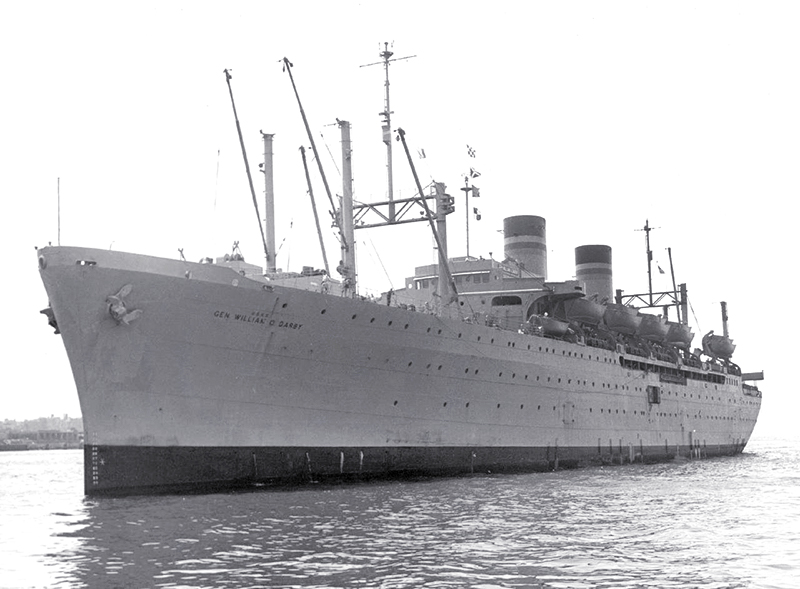 USNS GEN WILLIAM O. DARBY |
|||||||||||||||||||||||||||||||||||||||||||||
| USNS Gen William O. Darby | |||||||||||||||||||||||||||||||||||||||||||||
| Typical of the MSTS transports on the North Atlantic run is the USNS DARBY, a 30-knotter whose 22,574 displacement tons and 809-foot overall length make her comparable in size to ships such as the ANDREA DORIA and the STOCKHOLM.
The vessel's engines are driven by turbo-electric power, generating a total of 18,000 horsepower to drive the ship's twin screws. Civilian Crew: The DARBY has a civilian crew of 253 officers and men, including 27 waiters, 23 bedroom stewards, three stewardesses and a barber. The ship's crew is divided into six departments: the deck, engine, steward, purser, radio and military departments. The deck force, responsible for the navigation and maintenance of the ship, are divided into three "watches" which work four hours on and eight off, around the clock. Military Staff: The DARBY has a military staff of six Naval officers, including a commissioned nurse, 20 enlisted men and two WAVES. The staff is further augmented on each trip by a "voyage staff" of officer passengers who serve in every capacity from voyage staff CO and Exec, to a police and sanitary officer, an adjutant, a provost marshal and a compartment commander for each of the eight troop compartments. |
|||||||||||||||||||||||||||||||||||||||||||||
| 1963 | |||||||||||||||||||||||||||||||||||||||||||||
| (Source: SEALIFT Magazine, Aug 1963) | |||||||||||||||||||||||||||||||||||||||||||||
Headquarters of MSTS ELM is located at Grosvenor Square in London. |
|||||||||||||||||||||||||||||||||||||||||||||
| 1964 | |||||||||||||||||||||||||||||||||||||||||||||
| (Source: SEALIFT Magazine, Nov 1964) | |||||||||||||||||||||||||||||||||||||||||||||
From a recent article that appeared in the SERVICE FAMILY JOURNAL: |
|||||||||||||||||||||||||||||||||||||||||||||
| 1965 | |||||||||||||||||||||||||||||||||||||||||||||
| (Source: STARS & STRIPES, May 19, 1965) | |||||||||||||||||||||||||||||||||||||||||||||
| The Military Sea Transportation Service is in the process of streamlining its Eastern Atlantic and Mediterranean Command operations. As of July 1, the MSTS area headquarters in Europe will be moved to Bremerhaven, Germany. (Headquarters has been located in London since 1951.) In addition, an MSTS Office will be established at Rota, Spain, to replace the closing Naples office, and a new office will open at Rotterdam, the Netherlands. Commander of the new MSTS setup in Bremerhaven is Capt J. M. Seymour. After the reorganization, the Eastern Atlantic sub-area at Bremerhaven will have under its direct control Rotterdam; St. Nazaire, France; and London. The Mediterranean sub-area is headquartered at Leghorn (Livorno), Italy and will include the new Rota office. The command also has a representative at Frankfurt, Germany. MSTS at Bremerhaven will have a headquarters staff of 50 and will consist of a personnel and administration section, chief of staff, chief of operations, vessel operations section, cargo operations section and passenger operations section. Most of the cargo and passengers handled by the MSTS in Europe go through the port of Bremerhaven. Over a recent 6-month period, 67,000 total passengers and 100,000 tons of cargo were handled at Bremerhaven. |
|||||||||||||||||||||||||||||||||||||||||||||
| 1967 | |||||||||||||||||||||||||||||||||||||||||||||
| (Source: STARS & STRIPES, Nov 18, 1967) | |||||||||||||||||||||||||||||||||||||||||||||
| 15 MSTS ships per month are loaded at US east coast ports with supplies for the war effort in Southeast Asia. These ships cross the Atlantic and sail through the Mediterranean and the Suez Canal enroute to Vietnam. The Eastern Atlantic and Mediterranean section of the MSTS command (at Bremerhaven) assumes operational control of these ships after they reach midway in the Atlantic. Their movements are directed by the US Navy's European Command Center in London until the ships enter the AOR of the Pacific MSTS command. The MSTS at Bremerhaven extends over some 20 million square miles of land and sea and includes 60 ports in 25 countries. Between July and September (1967), 80,000 tons of supplies and military equipment was brought to Europe by MSTS ships for US forces and their dependents. |
|||||||||||||||||||||||||||||||||||||||||||||
| 1969 | |||||||||||||||||||||||||||||||||||||||||||||
| (Source: STARS & STRIPES, Oct 20, 1969) | |||||||||||||||||||||||||||||||||||||||||||||
| MSTSELM today has an area of responsibility that extends from the Atlantic coast of Europe to Burma, and from the North Pole to the equator. It encompasses 20 million square miles of land and sea and includes some 60 ports in 25 nations. MSTSELM, which includes a sub-area commander in Leghorn, Italy and MSTS offices in Rotterdam and London, is commanded by Capt Gerald W. Rahill. The command also has representatives in 15 locations throughout Europe, North Africa and the Middle East who serve MSTS on a part-time basis whenever ocean transportation of DoD cargo is involved. The bulk of military cargo coming into Europe moves through the Northern Europe ports of Antwerp, Rotterdam, Amsterdam, Bremerhaven, Bremen and Hamburg and into the inner regions by truck, rail and barge. Cargo to the United Kingdom moves primarily through London and Felixstowe on container services. The Mediterranean area still lags in facilities for container service but is moving to a greater use of container service as improvements come about. Among some of the dramatic changes in services provided by MSTS in the most recent years ships is the addition to the MSTS fleet of the USNS Admiral Wm. M. Callaghan, an early RO/RO cargo ship and the first of its type especially constructed for MSTS operations. She is chartered by the command for support of US forces in Europe. (Admiral Callaghan was the first commander of the MSTS.) |
|||||||||||||||||||||||||||||||||||||||||||||
| (Source: STARS & STRIPES, Oct 20, 1969) | |||||||||||||||||||||||||||||||||||||||||||||
| MSTS Eastern Atlantic and Mediterranean (MSTSELM) was located in London (as of 1951). A liaison office was set up at Heidelberg in January 1951. The office was located near the main headquarters of the US military command in Europe (at Campbell Barracks). MSTSELM headquarters was moved to Bremerhaven in 1965. |
|||||||||||||||||||||||||||||||||||||||||||||
| Military Sea Transportation Service Office Bremerhaven | |||||||||||||||||||||||||||||||||||||||||||||
 Headquarters, MSTS Office Bremerhaven |
|||||||||||||||||||||||||||||||||||||||||||||
 The MSTS mission - a troop ship pulls away from the pier at Bremerhaven in 1958, as it begins its voyage back to the States with US service members and their dependents returning from a tour of duty in Europe. |
|||||||||||||||||||||||||||||||||||||||||||||
| Troopships | |||||||||||||||||||||||||||||||||||||||||||||
| US Army TC / MSTS Troopships 1940s & 1950s | |||||||||||||||||||||||||||||||||||||||||||||
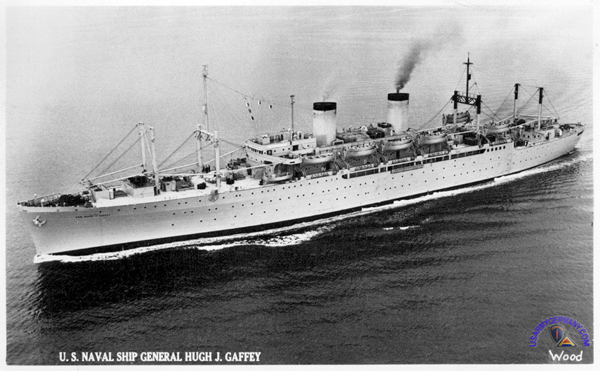 USNS General Hugh J. Gaffey (T-AP-121) (Jim Gibson) |
|||||||||||||||||||||||||||||||||||||||||||||
| Some of the troopships (more accurately: P-type passenger ships) that sailed back and forth between the ZI and Bremerhaven transporting troops and dependents: From 1946 to 1950, the transports served as part of the Army Transport Service. In 1950, the ships were transferred back to the US Navy and assigned to the Military Sea Transportation Service. Other ships were added to the regular Atlantic service at a later date: |
|||||||||||||||||||||||||||||||||||||||||||||
| 1948 | |||||||||||||||||||||||||||||||||||||||||||||
| (Source: STARS & STRIPES, March 6, 1948) | |||||||||||||||||||||||||||||||||||||||||||||
| The US Army transport General Simon B. Buckner is the first of a new fleet of Transportation Corps vessels to provide a "deluxe" passenger service to overseas bases for the US armed forces. These troop ships will complete the normal 14-day run across the Atlantic in under nine days. The General Buckner, with 1,375 passengers, left the New York Port of Embarkation (at Brooklyn) on March 4 and is expected to arrive at Bremerhaven on March 11 or 12. The Buckner was formerly known as the transport Admiral E. W. Eberle. The ship was converted for its new role at a cost of $4.5 million. The Buckner is one of ten TC vessels (1) that make up the TC fleet - five of the transports are earmarked for Atlantic service, the others will be used in the Pacific. Troop accommodations consist of compartments four-bunks high. Dependent quarters consist of two, three, four and six-bunk cabins, most with connecting baths. Some of the cabins have settee berths, the upper berth folding into the ceiling. Troops and dependents have separate dining areas. The transports are also equipped with a playroom and playpens on the top deck, as well as nurseries. (1) Looking at the information provided on Wikipedia (www.wikipedia.org/wiki/P2_transport) it appears that only 8 of the ships actually entered into service as part of the Army Transport Service (T-AP-120 thru T-AP-127). Only four of these (the Patch, Buckner, Rose and Darby) were part of the regular Atlantic passenger service in the late 1940s and 1950s. Continue with Troopships in the 1960s |
|||||||||||||||||||||||||||||||||||||||||||||
| (Source: Email from Jim Gibson, Jim Gibson, 34th Hospital Train - see email) | |||||||||||||||||||||||||||||||||||||||||||||
| This is the ship (USNS General Gaffey - above) I went to Germany on the last of February and first of March 1955. Keep up the good work your doing. I enjoy it. Jim |
|||||||||||||||||||||||||||||||||||||||||||||
| MSTS (US Navy) Troopships 1950s | |||||||||||||||||||||||||||||||||||||||||||||
.jpg) USNS General Roy Geiger (T-AP-197) |
|||||||||||||||||||||||||||||||||||||||||||||
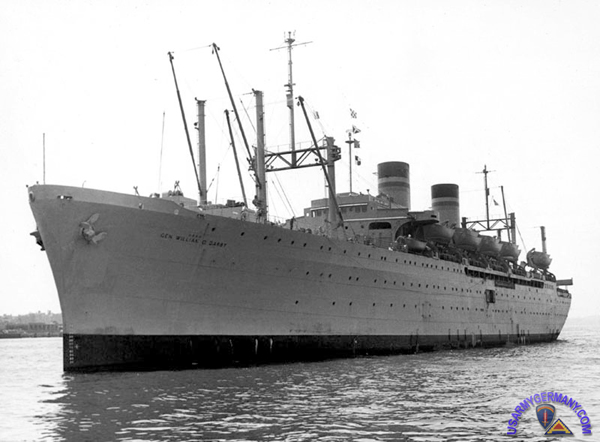 USNS General William O. Darby (T-AP-127) |
|||||||||||||||||||||||||||||||||||||||||||||
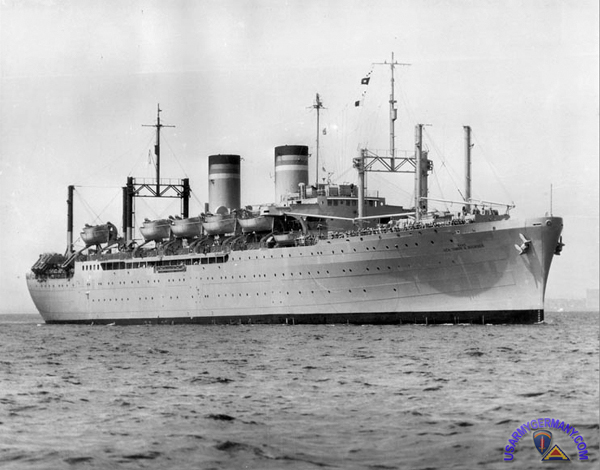 USNS General Simon B. Buckner (T-AP-123) |
|||||||||||||||||||||||||||||||||||||||||||||
| 1957 | |||||||||||||||||||||||||||||||||||||||||||||
| (Source: Email from Jerry Coombs, son of Donald Coombs who was assigned to the 78th Engr Bn, 1957-58) | |||||||||||||||||||||||||||||||||||||||||||||
| The 78th Engineer Battalion (C), of which Donald Coombs was a member, was designated for assignment in Germany under Operation GYROSCOPE in early 1957. The battalion's mission was to replace the 499th Engineer Battalion (C) stationed in Karlsruhe. Throughout the following months the battalion went through intense training to prepare for the trans-Atlantic move and the new overseas mission. In early February, the battalion was transported by train to the Brooklyn Army Terminal, N.Y. where it was embarked on the USNS Geiger for shipment to Germany. The Geiger sailed on February 4, 1957 and, after a stormy winter crossing, arrived at the Bremerhaven Port of Embarkation in northern Germany on the 13th. The troops debarked from the Geiger and boarded a military train that transported the unit to its new home at Phillips Barracks, Karlsruhe where it arrived on the 14th. |
|||||||||||||||||||||||||||||||||||||||||||||
|
|||||||||||||||||||||||||||||||||||||||||||||
| MSTS Troopships 1960s | |||||||||||||||||||||||||||||||||||||||||||||
| 1966 | |||||||||||||||||||||||||||||||||||||||||||||
| (Source: STARS & STRIPES, July 14, 1966) | |||||||||||||||||||||||||||||||||||||||||||||
| On July 13, 1966 the Defense Department announced that all transatlantic travel of troops and dependents on ships of the Military Sea Transportation Service would end on July 21, 1966. (It was also announced that Trans-Pacific service would also be stopped - on Aug 15.) Bremerhaven officials reported that port calls for servicemen and US Forces families due to return to the US aboard MSTS ships would be rescheduled for air transportation. Affected were passengers scheduled to leave Bremerhaven aboard the transports Buckner on July 31, the Geiger on Aug 6, the Rose on Aug 13 and the Geiger on Aug 30. Passengers scheduled to leave Bremerhaven on the Rose on July 17 would not be affected. The DoD announcement also stated that the current MSTS fleet of 15 transports would be cut to 8 in the next 12 months. All but one of the trans-Atlantic service ships would be used to support Vietnam operations. The four Atlantic-run ships to be used to support military operations in SE Asia are the Patch, Darby, Buckner and Geiger. The ships are required to move more combat and support troops to Vietnam during the current buildup. (In June, sailings of the Patch and Darby were cancelled and passengers were given a new port call for air travel from Rhine-Main.) MSTS ships generally carry 400 to 450 cabin-class passengers and some 1,000 servicement in troop compartments. Cargo runs by MSTS and MSTS-chartered ships are not affected by this announcement and will continue in the Atlantic and Pacific areas. (A subsequent article in the S&S, identified the Upshur, Darby, Buckner, Rose, Patch and Geiger as the former Atlantic-run transports that would be sent to the Pacific to support operations in VN. In 1965, these six trans-Atlantic service transports carried 200,000 troops and dependents between New York and northern European ports - Southampton and Bremerhaven.) |
|||||||||||||||||||||||||||||||||||||||||||||
| 1970 | |||||||||||||||||||||||||||||||||||||||||||||
| (Source: STARS & STRIPES, Jan 24, 1970) | |||||||||||||||||||||||||||||||||||||||||||||
| The Military Sea Transportation Service has announced that eight of its troopships (including the Rose, Patch, Darby and Buckner) are being inactivated by the end of June 1970. All eight played important roles in the past 25 years carrying troops, dependents, refugees and war brides between Europe, the US and the Far East. During the US military buildup in Vietnam, the troopships were taken off their normal trans-Atlantic and trans-Pacific runs and carried two-thirds of the troops from the US to Vietnam combat. Six of the eight (including the four former trans-Atlantic vessels) are now moored in New York and will be transferred to the Maritime Administration reserve fleet at James River, Va. (The other two are now in San Francisco and they will be taken to the reserve fleet at Suisun Bay, Calif.) The only remaining troopships in the MSTS fleet are the Geiger, Upshur (both former trans-Atlantic vessels) and the Barrett. |
|||||||||||||||||||||||||||||||||||||||||||||
| Related Links: |
|||||||||||||||||||||||||||||||||||||||||||||
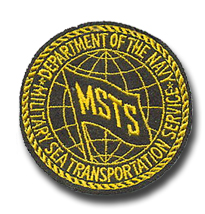
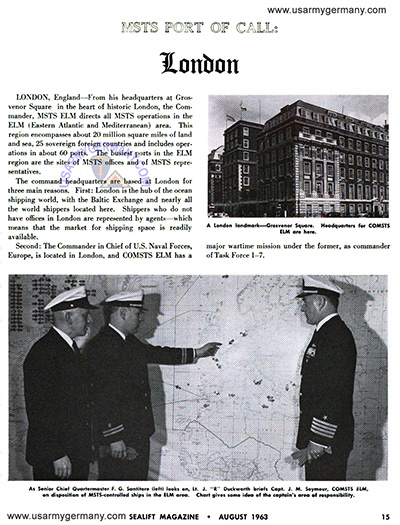
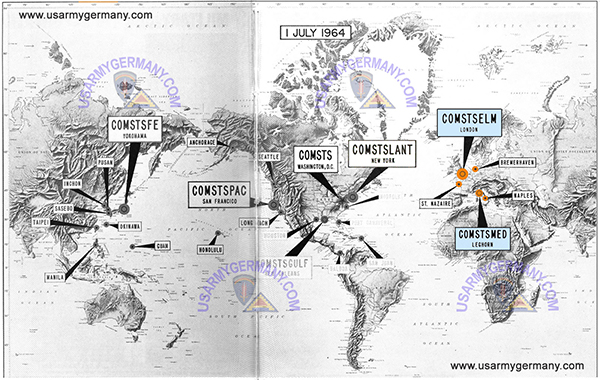
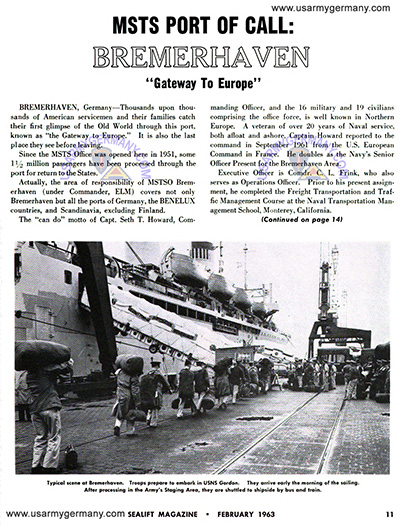
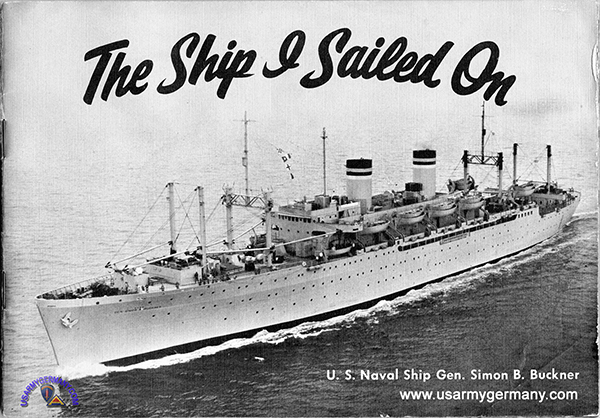
 postcard, early 1950s - AHEC 600.jpg)
